Formation and destruction of striation plasmas in helium glow discharge at medium pressures
Hailong ZHU (朱海龍), Qixiang HUANG (黃琪翔), Yifan WU (吳一繁),Yurui LI (李昱瑞) and Kechang REN (任克昌)
College of Physics and Electronics Engineering,Shanxi University,Taiyuan 030006,People’s Republic of China
Abstract The striation plasmas are usually generated within a positive column of glow discharge, where rich and complex physical interactions are involved,especially,in the medium or high pressures.Along these lines, our work aims to thoroughly investigate the formation and destruction of helium striation plasmas at kPa level pressures.The characteristics of the helium striation plasmas,and especially the optical emission properties are explored.The emission lines of 706.52 nm and 391.44 nm related to the energetic electrons and the high-energy metastable helium atoms respectively, were focused on in this work.The formation of striation plasmas in a helium glow discharge, is mainly associated with the instability originating from the stepwise ionization of high-energy metastable state atoms,Maxwellization of the electron distribution functions and gas heating.Additionally, the destruction effect of helium striation plasmas is of great significance when a small amount of nitrogen or oxygen is mixed into the discharge plasmas.The reduction of the mean electron energy and the consumption of the high-energy metastable helium atoms are considered as the underlying reasons for the destruction of striation plasmas.
Keywords: striation plasmas, medium pressures, atomic emission spectroscopy, helium discharge, metastable atoms, ionization wave
1.Introduction
Striation plasmas are regarded as a very interesting phenomenon and characterized by a periodic bright and dark pattern.They are usually generated in the positive column region of glow discharges that stem from both inert and molecular gases at various gas pressures.Moreover,rich and complex physical interactions take place, so several relevant studies have been conducted,especially on the formation conditions of striations, as well as the underlying physical mechanisms [1-4].The striations usually appear in two kinds, namely moving striations and standing striations.As far as the standing striations with a longitudinally periodic stationary structure are concerned, they are easily observable with the naked eye and were first reported in 1843 by Abria [5, 6].During the discharge of rare gases,standing striations take place in a form of damping oscillations in front of the cathode or by the anode side of a plasma perturbation induced by changes in the discharge conditions[3,7,8].In contrast,moving striations are not perceived by the naked eye due to their high velocity (10-1000 m s-1) and frequency (1-1000 kHz) [3].We have to underline that the formation of striations is often dependent on and sensitive to the local pressure and current conditions.Most of the striations were found within a discharge tube at low-pressure values (Pa level)with currents of milliamperes level, whereas such striations are most well understood and documented.Furthermore, the dependence between the striation length (e.g.the distance between the front of two striations) and the pressure can be estimated by the following expression:l/l0=(p0/p)m,which is conventionally called the Goldstein-Wehner relationship,where l is the striation length when the pressure is p,l0is the striation length when pressure is p0,and m is a constant depending upon gas composition.At low-pressure values, Novak’s rule is available for small current distributions,while this potential drop of the striations is close to the ionization potential (first excitation energy for rare gas) [9].In addition, an upper current boundary exists, namely the so-called Pupp boundary, which separates the striation and the non-striation plasmas on the pressure versus current(pR,I/R)diagram,where R is the radius of the discharge tube, and I is the discharge current [10].More specifically, for the helium discharge the boundary for appearance or disappearance of striations can be expressed as follows:I=A/(pR)5,where A is equal to 160 and 30,respectively,at the cathode and anode positions [11].It is interesting to notice that Tsendin provided a significant contribution in explaining the formation striation mechanism at low-pressure and proposed that such striations stem essentially from kinetic-based interactions.The electrons injected from the cathode are accelerated by the electric field and gain kinetic energy w.When the kinetic energy w reaches the excitation threshold ε1at a distance λ, the electrons will experience an inelastic collision with atoms, lose energy equal to ε1,and will be accelerated again.On top of that,this process is repeated periodically.In this way,the alternating bright and dark luminous layers are formed with a spatially periodic field and electron distribution functions(EDF)[12,13].
As the pressure increases to medium values(~103Pa)[14],the formation of the striation plasmas is usually accompanied by the constriction of the discharge channel.For instance, the constricted-striation plasmas have been observed experimentally in helium at 13-50 kPa[7],whereas in argon-nitrogen mixtures at 10 kPa [15].In contrast to the low-pressure discharges, the formation of striation plasmas at medium/high pressure exhibits more complex physical mechanisms due to the manifestation of more frequent ionization and recombination events.In addition,apart from the electron-atom collisions, the electron-electron collisions also have to be considered during the discharge process.Insights from numerical calculations reveal that the formation of this striation plasmas is originated from the ionization instability or manifestation of ionization oscillations and waves,which might be induced by the combined effects of inhomogeneous gas heating,stepwise ionization,as well as the influence of electron-electron collisions on the EDF [10, 16, 17].Moreover, the development of the instability in both radial and longitudinal directions yields a constriction and stratification plasmas.Yu Golubovskii confirmed that the discharge constriction effect is mainly determined by the nonlinear dependence of the ionization rate on the electron density, while the inhomogeneous gas heating plays a secondary role[18,19].The stepwise ionization by metastable state atoms and Maxwellization of EDF are also possibly associated with the plasma stratification.During inert gas discharges, i.e.in helium discharge,abundant high-energy metastable atoms with the greatest amount of energy(~20 eV)can be produced,which creates the necessary conditions for stepwise ionization.Once the stepwise ionization dominates the whole ionization process, it may raise the ionization instability or wave and develop along the discharge channel.Moreover, under higher pressures, as the ionization frequency increases,the EDF becomes more Maxwellian since the electrons begin to interact with one another for exchanging their energies.Hence, at this time, the electron density increases via ionization.When current exceeds a critical value,the instability develops and could lead to the longitudinal modulation of the plasmas [1].
In recent years,more striation plasmas were experimentally observed at medium pressures [15, 20], even at high pressures[21, 22].Indeed, the striation plasmas are undesirable in most cases since reducing the efficiency of practical applications like gas lasers.In view of the fact that our understanding of such striation plasmas is still limited[23],therefore,more research is required.Along these lines, in this work, a helium striation plasma is reported, which was generated at medium pressures around 20.00 kPa driven by a direct current pulse power supply.On top of that, the optical characteristics of helium striation plasmas were investigated by enforcing the optical emission spectroscopy(OES)technique.The role of metastable atoms on the formation of helium striation plasmas was also thoroughly analyzed.The striation plasmas can be effectively destructed by adding a small amount of molecular gas with low ionization energy,which destroys the metastable atoms and modifies EDF,while the potential destruction mechanisms were discussed.
2.Experimental setup and methodology
The experimental arrangement of this work is schematically illustrated in figure 1.Similar to previous work[7],the discharge plasma was generated between the two needle copper electrodes,which were placed within a stainless-steel chamber.The pressure inside the chamber was detected by a commercial gauge with an accuracy of ±0.5% (DL-4, Peking University, China).A rotary vane pump was employed in order to pump air out the chamber and maintain the background pressure at 8.00 kPa,and then the helium gas was injected until the pressure reaches the value of 20.07 kPa.Fixing the electrode gap at 1 mm, a voltage with amplitude of 500 V was applied to the electrodes,the discharge plasma was generated between the electrode gaps.Subsequently,slowly adjusted the electrode gap to 10 mm, an identifiable striation plasma in the positive column could be observed by the naked eye.When the diatomic gas mixture O2/N2was separately injected into the discharge plasma, the striation pattern would be destructed gradually, and then a continuous plasma column was formed finally between the discharge electrodes.A digital camera (Canon EOS760D, Japan), as well as a spectrometer (Avaspec ULS2048 USB2, Avantes, Netherlands) was employed in order to record the discharge images and diagnose the discharge characteristics, respectively.Moreover, the image taken settings are f-number of 5.6, ISO of 1600 and exposure time of 1/200 s, respectively.
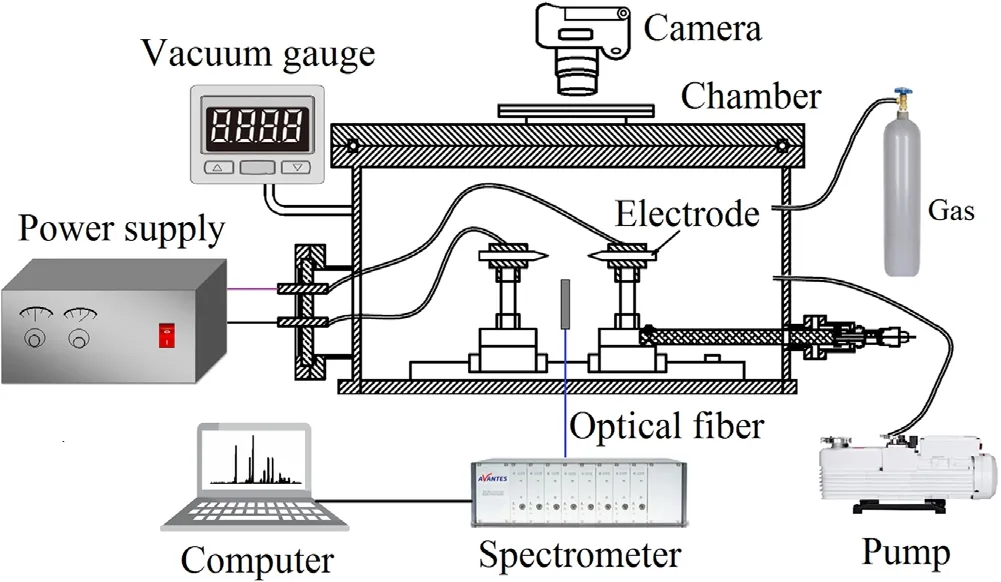
Figure 1.Schematic diagram of the experimental arrangement.
3.Results and discussions
3.1.Formation and characteristics of helium striation plasmas
Figure 2 shows the typical helium striation plasmas generated at 20.07 kPa pressure and 10 mm electrode gap.It is interesting to notice that the discharge exhibits alternating bright and dark striation plasmas, which are distributed near the cathode, and it becomes more diffuse closer to the anode.In comparison with the argon striation plasmas [20], the helium striation plasmas reveal a wider striation separation (He:~1 mm, Ar: ~0.5 mm) under the same discharge conditions,since helium has a higher first excitation energy threshold(He:19.82 eV, Ar: 11.5 eV).For both helium and argon striation plasmas, the striation separation is sensitive to the gas pressure.More specifically,the higher the gas pressure,the smaller the average free path of the electrons, so that results in a smaller striation separation.In addition,the discharge channel of the helium is more diffuse, while the contraction effect is less intense than argon discharge, which is ascribed to the smaller atomic mass and elevated thermal conductivity [24].

Figure 2.Typical helium striation plasmas at a gas pressure of 20.07 kPa and electrode gap of 10 mm.
Figure 3 shows the OES characteristics of the helium striation plasmas.From the acquired data we can observe that the main emission lines are dominated by He Ι at 706.52,667.82, and 587.56 nm.Additionally, some weaker spectral lines ofat 391.44 nm,Balmer Hαat 656.28 nm,and triplet O at 777.54 and 844.63 nm were detected, indicating the presence of a certain amount of air and water vapor within the chamber.Notably,the spectral line 391.44 nm is derived from the Penning ionization between the helium metastable atoms and the nitrogen impurity, and is well-known as an indicator of the presence of highly energetic helium metastable (Hem).The process can be expressed as follows [25]

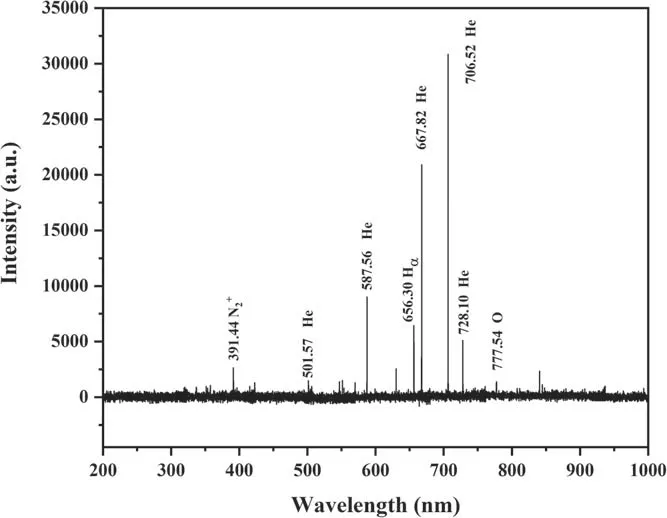
Figure 3.Typical optical emission spectroscopy of the helium striation plasmas under the application of the same discharge condition as in figure 2.
Figure 4 presents the energy levels and the related transitions for the strong emission lines of the helium discharge process.The dominated emission at 706.5 nm is a consequence of the transition from He (33S →23P).On top of that,the population of the upper level33S occurs by the direct electron collisional excitation from the ground (threshold energy of 22.72 eV), as well as metastable states of helium(threshold energy of 22.72-19.82 = 2.90 eV).The latter process is quite important for light emission at 706.5 nm due to the lower threshold energy.The process of33S state and emission of 706.5 nm can be visually expressed by employing the following equations:
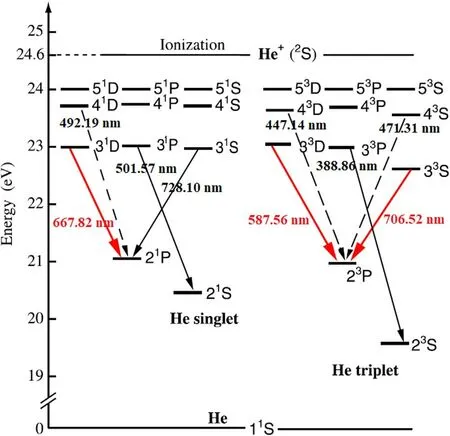
Figure 4.Energy-level diagram for the helium excited states and optical emission transitions of the excited states observed in figure 3.The red line represents the transitions of the three strong emission lines, the solid lines stand for weaker emission lines, while the dashed lines signify unobserved emission lines in the experiment.

From the high emission intensity of 706.52 nm we can experimentally demonstrate the presence of energetic electrons with energy greater than 22.72 eV [26].Alternatively,the production of rich metastable atoms (Hem21S and 23S),especially Hem(23S) during the discharge process is also evidenced.Hem(21S) rapidly converts to Hem(23S) by spinexchange-related reactions with free electrons,hence the Hem(23S) becomes a key focus in the helium discharge study.Some experimental studies have demonstrated that the Hem(23S)atom density is usually much higher than the respective value of Hem(21S)[27,28].Due to the high-energy and long mean lifetime of the metastable atoms(e.g.8400 s for 23S and 0.02 s for 21S) [29], they are considered as an important energy reservoir for ionizing and exciting helium atoms by collisional-based processes[30-32].Moreover,by taking into account that the ionization processes of the helium discharge of this work,besides the electron direct impact ionization,the stepwise ionization imposed by rich high-energy metastable atoms becomes more significant or even might be dominant at higher pressures [33].This effect is attributed to the lower ionization threshold energy of the metastable atoms (e.g.4.76 eV for 23S and 3.97 eV for 21S level),compared with the threshold energy direct impact ionization (24.58 eV).The stepwise ionization can be visually expressed by the following equations:

The stepwise ionization caused by the metastable atoms can lead to an ionization instability, which manifested as a nonlinear dependence of the ionization rate on the plasma density[10, 17].Once metastable atoms are quenched (discussed in section 3.2), the nonlinear relationship would be destroyed,while the ionization instability would be weakened, and as a result, the discharge becomes stable.
A perturbation theory can be used for analyzing the ionization instability.By assuming that a small perturbation occurs during the discharge process,thus,the electron densitynecan be expressed as follows [34]:

wherene(r) is the steady-state electron number density, and(r,t) exp (- ikz)is the perturbed electron density.Furthermore,kis determined by the longitudinal scale of the perturbation,λ= 2π/k.
Equation (9) is subsequently substituted into the particle balance equation (10)

whereDAis the ambipolar diffusion coefficient, ands the ionization frequency.After simplifying the equations and ignoring the small terms,the perturbation equation is obtained as follows:

3.2.Destruction of the helium striation plasmas
Next, we focus on one another important process, namely destruction of the striation plasmas, and the factors related to it.At elevated pressure values,the destruction of the striation plasmas usually is arisen by increasing the pressure or current in a certain discharge gas.Physically,with the increase of the pressure or current, on one hand, electrons collide with helium atoms more frequently, which leads to a decrease in the mean electron energy and change of the shape of the EDF to Maxwellian distribution.Alternatively, the ionization instability damped yielding a balance of the ionization process.Consequently, the discharge transitions from striations to continuous patterns.More notably,striation patterns can be more effectively suppressed or destructed by mixing other trace-gases.Figure 5 exhibits the evolution of the helium striation plasmas with mixing nitrogen (a)-(c) and oxygen(d)-(f) at different pressures.After the formation of striation plasmas at 18.35 kPa (figure 5(a)), when a small amount of nitrogen (0.9%) was slightly injected, the discharge became more diffuse (figure 5(b)) from the significant striation pattern, and then nearly disappeared at a nitrogen content of 3.5%.Interestingly, the destruction effect of striations was more substantial when oxygen (electronegative gases) was mixed.As figure 5(f) indicated, the striations are almost indistinguishable from the naked eye at mixtures of 1.5 vol%of oxygen.Figures 5(g)-(i) display the discharge images of the helium striation plasmas with and without additional gas at the same pressure of 18.55 kPa.In the absence of additional gas, the striations are clearly discernible, as highlighted in figure 5(g).At the same pressure, with the presence of additional nitrogen/oxygen(1.0%),as revealed in figures 5(h)and (i), the striations nearly disappear.This effect clearly demonstrates that the presence of impurity gas is unfavorable to the survival of striations under this pressure level.
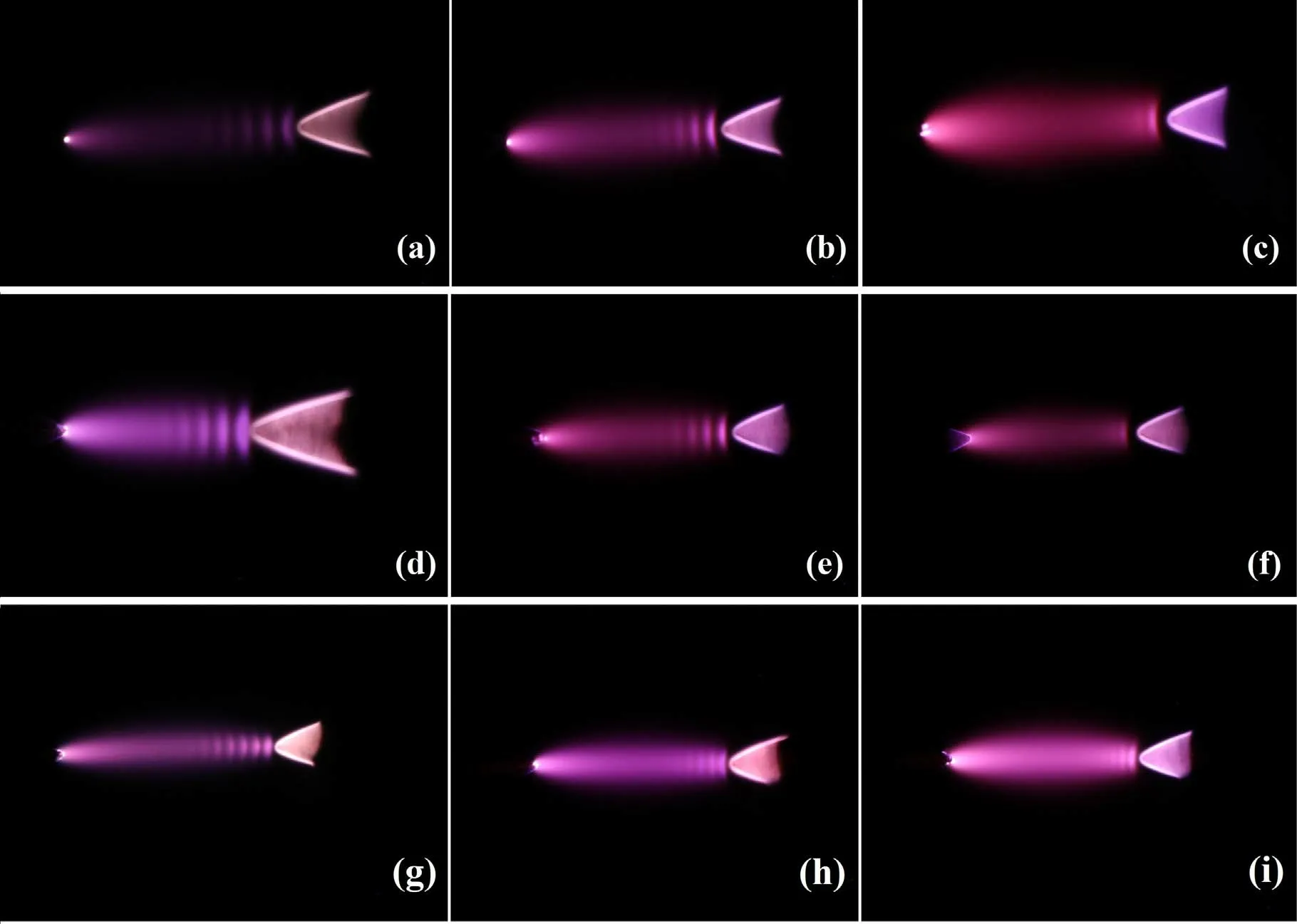
Figure 5.Evolution of the helium striation plasmas by adding nitrogen and oxygen at different pressures.(a)Initial helium striations at 18.35 kPa(N2 0.0%),(b)18.51 kPa(N2 0.9%),(c)18.99 kPa(N2 3.5%),(d)another initial helium striations at 20.07 kPa(O2 0.0%),(e)20.13 kPa(O2 0.3%), (f)20.37 kPa (O2 1.5%).(g)-(i) Helium striation images with and without additional gas at the same pressure of 18.55 kPa,(g)helium striations, (h) (N2 1.0%), (i) 18.55 kPa (O2 1.0%).
The typical OES patterns of the helium striation plasmas with a small mixture of nitrogen (a) and oxygen (b) are divulged in figure 6.Besides the dominant emission lines of helium, the sub-strong nitrogen molecular bands involved a neutral nitrogen molecular spectrum (C3∏u→ B3∏g) at 337.13 nm and 357.69 nm, while a molecular ion spectrumat 391.44 nm was also identified, and the intensity of the relevant spectral lines was enhanced as the mixture of 0.9 vol% of nitrogen gas.
The variations in the intensity of emission lines from helium and mixture gases were investigated with respect to the mixture gases volume percentage.As disclosed in figure 7(a), the intensity of the dominant emission lines of helium (706.52 nm, 587.56 nm, and 667.82 nm) indicated a significant decline as the gradually mix nitrogen increased.On the contrary, the intensity of the main emission lines related to nitrogen (337.13 nm, 357.69 nm and 391.44 nm)enhanced and then remained steady.The emission lines of 337.13 and 357.69 nm are associated with the direct electron impact of nitrogen molecules, while 391.44 nm is derived from the Penning effect(reactions(1)and(2)).The mixture of a small amount of nitrogen imposes two important changes in the discharge process,which are attributed to the larger size of the nitrogen molecules and atoms than helium atoms.The first one is the change of the mean electron energy,or the electron energy distribution function due to the additional electronnitrogen direct impacts that consume many energetic electrons.The other one is the quenching of high-energy excited state atoms of helium, especially, metastable helium atoms.We have to underline that energetic electrons are consumed in large quantities as a mixture of nitrogen,resulting in the EDF tending to the Maxwellian distribution of the equilibrium state.This assumption can be confirmed from the enhancement of the emission line of 337.13 and 357.69 nm, which stems from the vibrational and rotational excitation of nitrogen molecules(lower threshold energy excitation channels in nitrogen molecules) by lower-energy electrons.On the other hand,the population of the metastable helium atoms reduces,which is associated with a decrease of the high-energy tail of the electron energy distribution function, whereas they are efficiently quenched by the Penning reaction.The change of the emission line at 391.44 nm is the result of the quenching to the helium metastable atoms caused by nitrogen in the Penning reaction [36, 37].Consequently, the contribution of the stepwise ionization induced by metastable atoms to the total ionization is reduced.Therefore,the important condition of the ionization instability is destroyed, which leads to the destruction of striation plasmas.
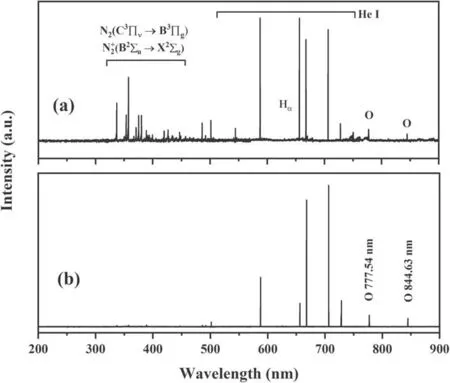
Figure 6.Optical emission spectroscopy of the helium striation plasmas under a discharge condition: (a) mixture of 0.9 vol% of nitrogen gas,corresponding to figure 5(b),(b)mixture of 0.3 vol%of oxygen gas, corresponding to figure 5(e).
On top of that, when a small amount of oxygen (0.3%)was mixed into striation plasmas, the three strong emission lines of the helium and the oxygen atomic lines at 777.54 and 844.63 nm can be detected, as displayed in figure 6(b).The impact on the main helium emission line intensity of a mixture of oxygen follows a similar trend to the one observed for the mixture of nitrogen.As can be ascertained from figure 7(b),the dominant emission lines of helium,especially,706.52 nm (represent the density of the energetic electrons),decreased dramatically by increasing the concentration of the oxygen gas.Similar to the mixing of nitrogen into ionized helium, the reduction of the dominant emission line 706.52 nm is mainly attributed to the consumption of energetic electrons and excited helium atoms by the direct electron impact on oxygen.Additionally, since oxygen is an electronegative gas, the electrons are lost by the direct attachment to oxygen producing atom or molecule ions,which leads to a decrease of the electron density and the mean electron energy.Alternatively, the intensity of the emission lines of oxygen atom O at 777.54 nm (3p5P → 3 s5S)(roughly signifies the density of the lower energy electrons)increases slightly, which is consistent with our assumption that the helium metastable atoms must participate in the excitation of oxygen in our discharge condition.The upper energy level of the oxygen atom O(3p5P)is produced by the quenching of helium metastable atoms by molecular oxygen[38]

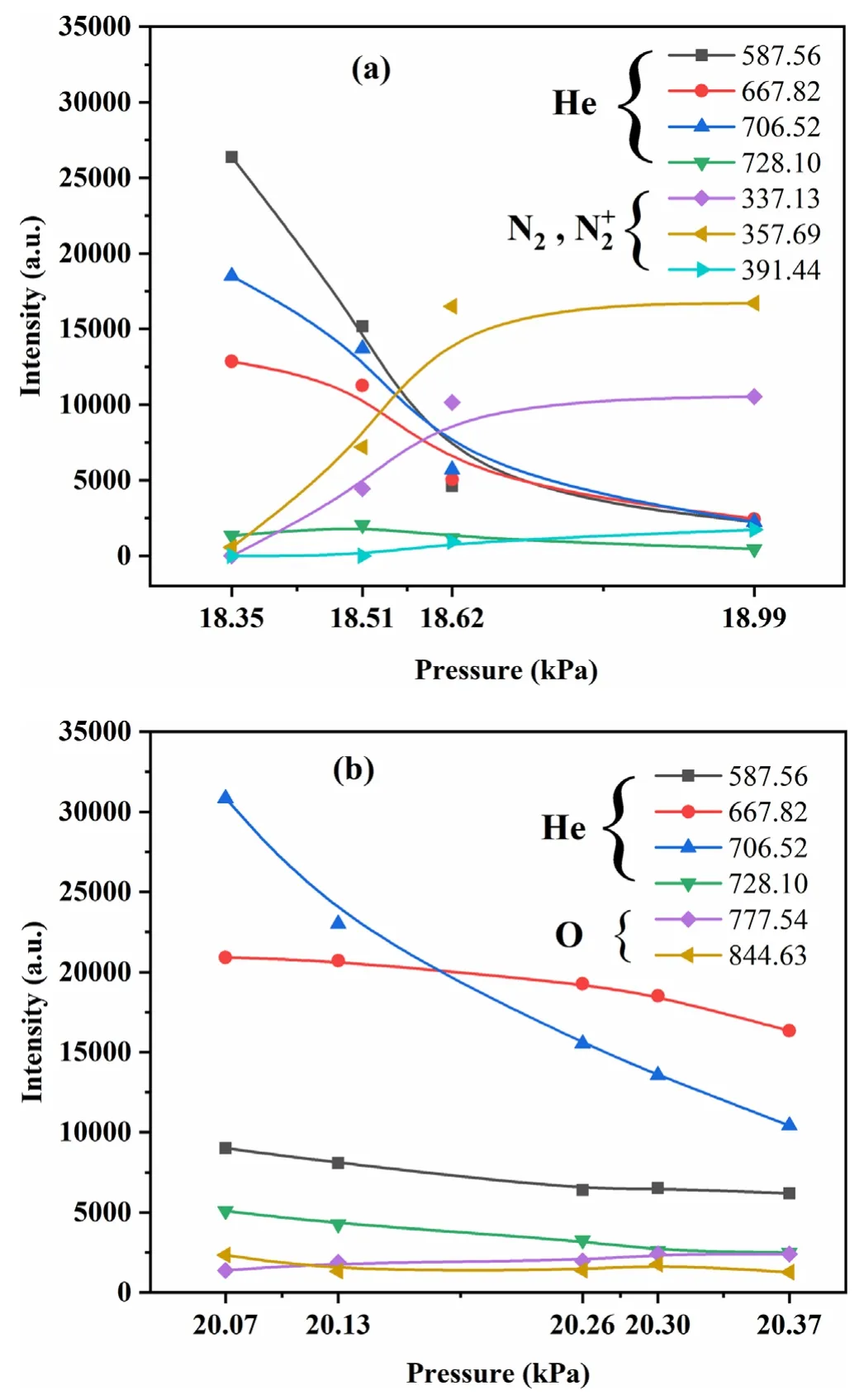
Figure 7.Variations on the intensity of the emission lines with mixture of nitrogen (a), and with mixture of oxygen (b).
Generally,in pure helium gas discharge,the quenching of the metastable atoms mainly originates from the collisions with electrons and ground state helium atoms.When the molecular gas impurities are mixed in,the energy transfer to the mixture gas becomes important, while the metastable helium atoms are consumed by the mixture gases.It has been demonstrated that the quenching rate of metastable helium atoms by oxygen molecules is higher than by nitrogen molecules [39].This outcome is consistent with our result that the very low emission of nitrogen molecular ion at 391.44 nm as illustrated in figure 5(b),indicates that the majority of metastable helium atoms have been quenched by oxygen.Furthermore, this is also in direct agreement with the striation plasmas, which were easily destructed by a smaller mixture amount of oxygen than nitrogen (figure 5).
4.Conclusions
From our analysis, we can draw the conclusion that the formation of striation plasma is closely related to the presence of the energetic electrons, as well as the high-energy metastable atoms in the helium discharge process at medium pressures.This assumption is in agreement with the results of the high emission lines of 706.52 and 391.44 nm from the Penning effect.Additionally, the EDF deviates from the Maxwellian shape, which is attributed to the energetic electrons, giving thus rise to an instability.Stepwise ionization caused by highenergy and long-lived metastable helium atoms, is also another source of instability.The admixture of nitrogen and oxygen leads to the effective EDF conversion to Maxwellian distribution, as well as the metastable helium atoms were consumed in large quantities.This effect is equivalent to the instability factor that is destroyed by nitrogen/oxygen.Hence,no striation plasmas were observed by the naked eye.
Acknowledgments
The study was supported by National Natural Science Foundation of China(No.11875039).We are also grateful to Dr.Yujun Shi from Shanxi University for his valuable discussion.
 Plasma Science and Technology2022年5期
Plasma Science and Technology2022年5期
- Plasma Science and Technology的其它文章
- Integrated data analysis on the electron temperature profile of HL-2A with the Bayesian probability inference method
- Prompt acceleration of a μ+ beam in a toroidal wakefield driven by a shaped steeprising-front Laguerre-Gaussian laser pulse
- The influence of weak transverse magnetic field on plasma dissipation process in the post-arc phase in a vacuum interrupter
- Numerical study of the effect of coflow argon jet on a laminar argon thermal plasma jet
- On the green aurora emission of Ar atmospheric pressure plasma
- Dynamic characteristics of multi-arc thermal plasma in four types of electrode configurations
